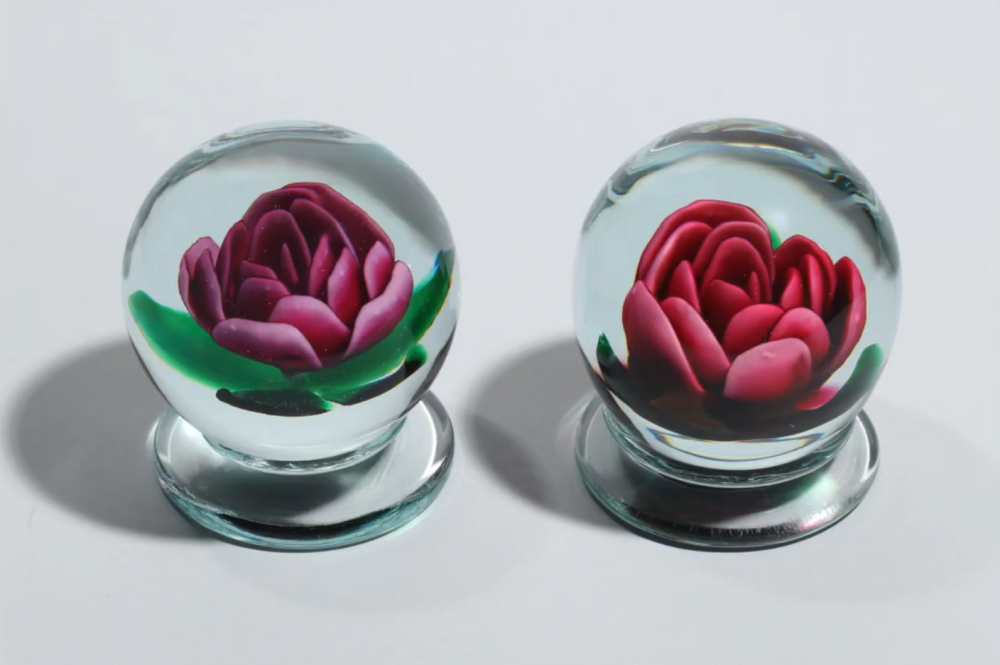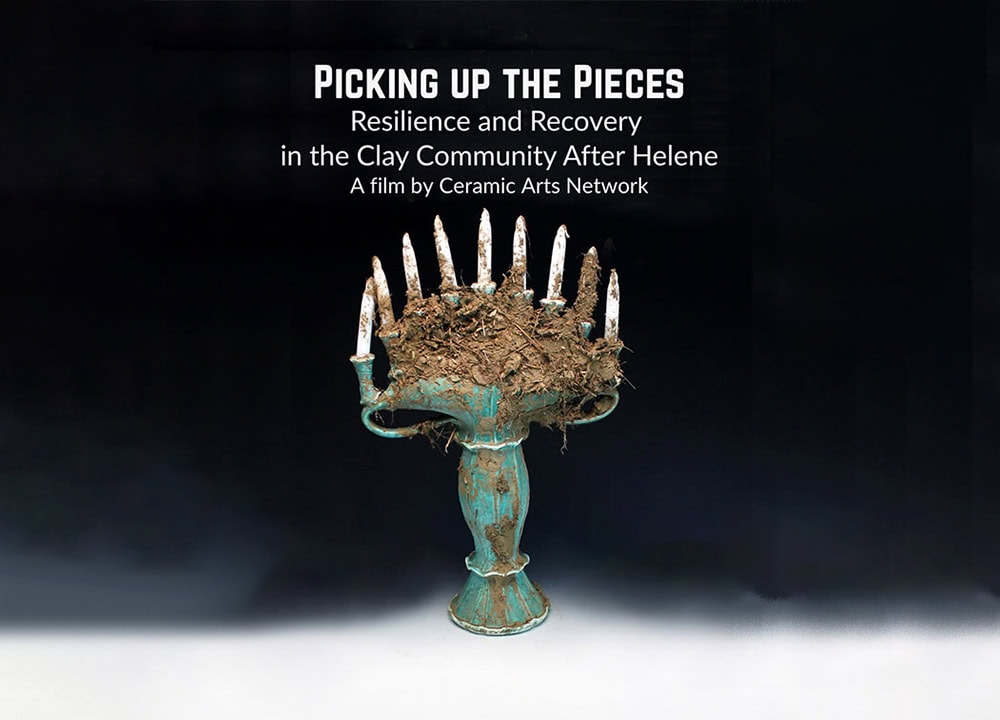
[Image above] Example of Millville Rose glass paperweights, created by glassblowers at Wheaton Arts and Cultural Center in Millville, N.J. Credit: Bob Fenster, YouTube
Ralph Waldo Emerson once said, “There is simply the rose; it is perfect every moment of its existence.” Although interpretation of what he meant varies, one suggestion is that you should “cherish the transient beauty of life.”
While most people can only cherish such beauty in the moment, for glass artists, their medium offers a unique way to impart some degree of permanency to these fleeting moments. A perfect example of this special ability is the famous Millville Rose, a beautiful glass paperweight cherished by collectors and glass artists alike.
History of glass paperweights
In the early 19th century, an increasingly urban population and an expanding market of goods created by the Industrial Revolution stimulated the manufacture of many new decorative novelties in Europe.
Glass paperweights are one of the decorative novelties that started appearing during this time. While the exact year and origin of the first glass paperweight is unknown, the first documented appearance can be traced to the Austrian Industrial Fair in 1845.
The first glass paperweights often drew upon the ancient glassmaking technique of millefiori canes to produce distinctive decorative patterns. This traditional style carried over into the first paperweights produced in the United States as well, such as by the New England Glass Company and Boston and Sandwich Glass Company in the 1850s. But soon U.S. companies started producing unique designs of their own—such as the Millville Rose.
Millville Rose: Inside the design of the first U.S.-style paperweight
The Millville Rose is considered the first U.S.-style paperweight based on its design and manufacture. Its creation is usually attributed to Ralph Barber, an immigrant from Manchester, England.
Barber’s family moved to the U.S. when he was 12, and following in the footsteps of his father, he started working at Whitall Tatum Company in Millville, N.J., in the 1890s.
Whitall Tatum Company was one of the first glass factories in the U.S. First opened in 1806, by the 1860s, Millville had developed a thriving glass industry because of its abundant supplies of sand and an influx of immigrants (typically from Germany, England, Sweden, and Italy) with the right skills.
Barber developed the Millville Rose design while working at Whitall. While many sources solely credit Barber for the design, others suggest it was more of a collaborative effort.
Regardless, what made the Millville Rose possible was Barber’s development of the metal crimp, a tool used to press the rose design into the glass. First color was added to the bottom or sides of a transparent glass orb, then the crimp would be pushed through the color and into the molten glass. With the design pressed into the orb, the flower looked like it was blooming—just like Barber’s real flowers in his garden at home.
In 1912, Barber left Whitall Tatum Company to become plant superintendent at Vineland Flint Glass Works. Established by Victor Durand Jr. and his father in 1897, this plant produced chemical and scientific glassware such as thermos liners, towel bars, light bulbs, and X-ray tubes.
While at the Vineland plant, Barber worked officially in X-ray tube production, but he did make several lily paperweights in his spare time. He attempted to make some rose paperweights as well, but without the setup of the Whitall Tatum Company, he was unsuccessful and eventually gave up.
Even though Barber did not successfully carry on his invention at Vineland, other glassblowers back at Whitall Tatum Company carried on the Millville Rose legacy.
Carrying on the legacy of the Millville Rose
After Barber revealed his crimping technique to the other Whitall Tatum glassblowers, they began experimenting with creating Millville Roses of their own. Colors ranging from ruby, pink, opal, and opalescent yellow colors were used for these paperweights, with some of the colors newly developed at Whitall Tatum Company.
Through this experimentation, the Whitall Tatum workers created new styles and techniques for fabricating the rose paperweights “…and created a tradition they felt worthy of passing down,” reports writing intern Alexandra Sikorski in a Smithsonian Center for Folklife and Cultural Heritage article.
Unfortunately, by the 1920s, the introduction of glass-forming machinery had largely replaced the need for industrial glassblowers and their teams. As a result, many of the original Whitall Tatum glassblowers were left making the famous Millville Roses as a hobby in their backyard shops. But the opportunity to share the craft more widely again became possible in the 1960s thanks to Wheaton Industries.
Wheaton Industries was established by Theodore Corson Wheaton in 1888. The company originally manufactured pharmaceutical glassware and continued to expand during the 1930s through the 1950s with the help of automation, under the leadership of Theodore’s son, Frank H. Wheaton.
In the 1960s, Frank H. Wheaton Jr. took over and founded Wheaton Village (now Wheaton Arts and Cultural Center, or WheatonArts) to help preserve the heritage of traditional glassmaking in southern New Jersey, including the Millville Rose. The Wheaton Village glass shop, where one can purchase a variety of paperweights, opened in 1972.
During the 1980s and 1990s, a new generation of glassblowers, such as Don Friel, learned to make the Millville Rose. The employees of Wheaton Industries were allowed to experiment with glass in exchange for narrating demonstrations. In this way, Wheaton Industries glass artists helped keep the tradition of the Millville Rose alive.
Concludes Sikorski in her Smithsonian article, “Along with WheatonArts, the Millville Rose is the remaining symbol of the industry that once defined the town for generations, a colorful objet d’art that rose amid the dirt and sweat of the factories.”
Further reading
View examples of various Millville Rose paperweights (some available for purchase) here, here, here, and here.
For more details on the paperweight fabrication process, see this Collectors Weekly article.
Watch these videos of featured WheatonArts artists, which were recorded during a virtual event put on by the shop in May 2020.
Read more on the history of Millville glass manufacturing here or here, or check out this book about the early days.
View the 2021 tour of the exhibition, People, Place, Process: 50 Years of Glassmaking at WheatonArts, at The Museum of American Glass.
Author
Laurel Sheppard
CTT Categories
- Art & Archaeology
- Glass


